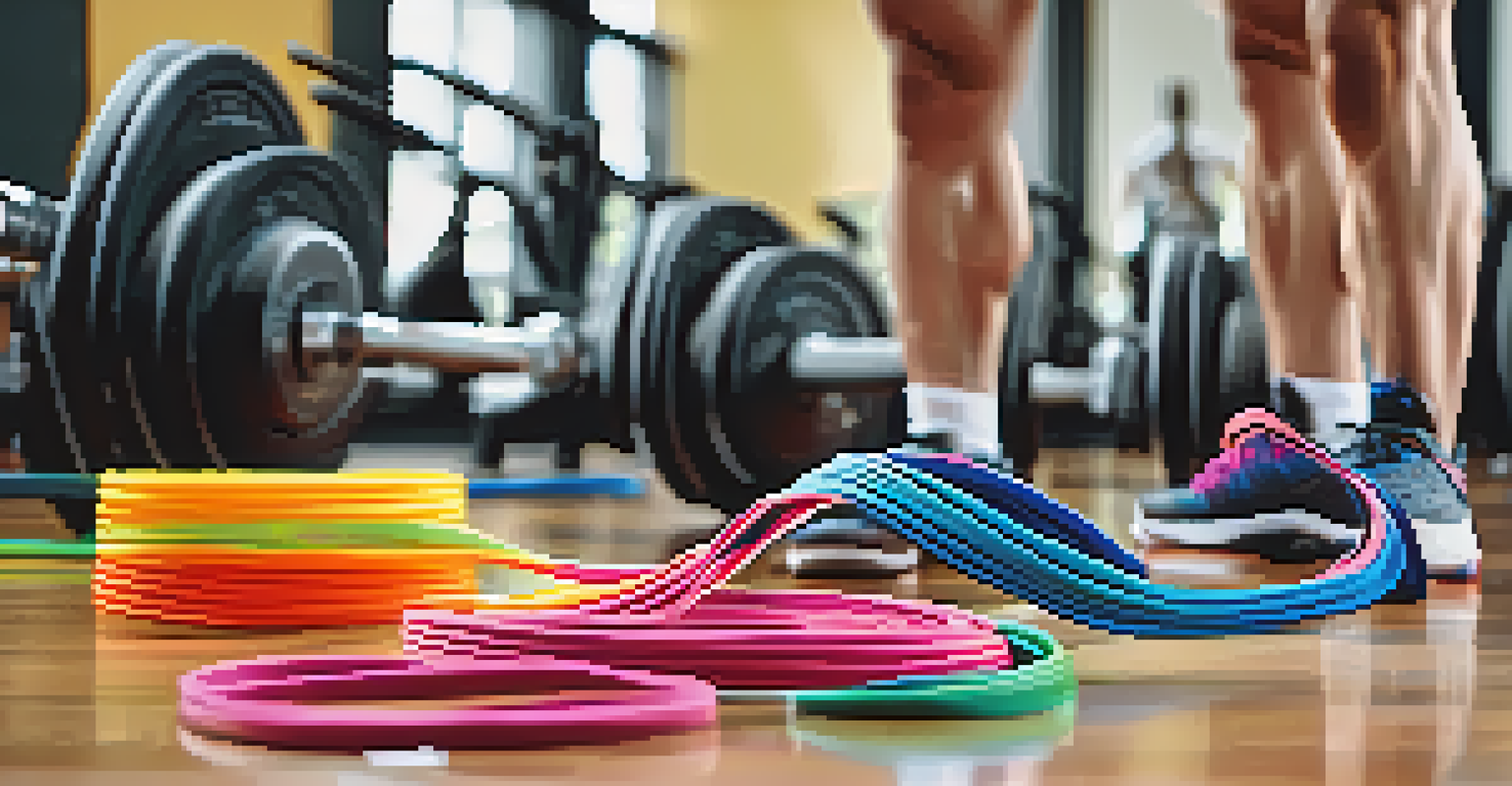Using Resistance Bands for Injury Prevention in Powerlifting

Understanding the Importance of Injury Prevention in Powerlifting
Injury prevention is crucial for powerlifters, as heavy lifting puts immense stress on muscles and joints. Without proper precautions, athletes risk not only setbacks in their training but also long-term damage. By prioritizing injury prevention, lifters can ensure longevity in their sport and maintain peak performance.
An ounce of prevention is worth a pound of cure.
Injuries in powerlifting often stem from muscle imbalances, improper form, or overtraining. These issues can lead to common injuries like strains and tears, which can sideline a lifter for weeks or even months. Understanding how to mitigate these risks is essential for anyone serious about their powerlifting journey.
Incorporating tools like resistance bands into your routine can make a significant difference. They are versatile, easy to use, and can be tailored to target specific muscle groups and movements, adding another layer of protection against injuries.
What Are Resistance Bands and How Do They Work?
Resistance bands are elastic bands that provide resistance during workouts, making them an excellent tool for strength training and rehabilitation. They come in various thicknesses, allowing users to choose the level of resistance that suits their needs. This adaptability makes them suitable for beginners and advanced lifters alike.

When using resistance bands, the tension increases as the band stretches, providing a different type of resistance compared to traditional weights. This unique mechanism can help strengthen stabilizing muscles essential for maintaining proper form during lifts. Additionally, they can enhance flexibility and mobility, which are key components in injury prevention.
Injury Prevention is Essential
Prioritizing injury prevention allows powerlifters to maintain peak performance and ensure longevity in their sport.
For powerlifters, incorporating resistance bands can help improve the strength of muscles that support the main lifts: squat, bench press, and deadlift. By focusing on these supporting muscle groups, lifters can build a more balanced physique, reducing the risk of injury during heavy lifts.
Strengthening Weak Areas with Resistance Bands
One of the most effective ways to prevent injuries is to identify and strengthen any weak areas in your body. Resistance bands can be particularly useful in targeting these weak links, as they allow for a variety of exercises that focus on specific muscle groups. For example, banded exercises like lateral band walks can help strengthen the hip abductors, crucial for stabilizing the squat.
Strength does not come from physical capacity. It comes from an indomitable will.
By regularly incorporating resistance band exercises into your training routine, you can address muscle imbalances that might otherwise lead to injuries. This proactive approach not only enhances your overall performance but also boosts your confidence in executing heavy lifts.
Moreover, resistance bands provide a low-impact option for strengthening muscles without the risk of heavy weights. This is especially beneficial for athletes recovering from previous injuries or those who want to avoid putting excessive strain on their joints.
Enhancing Mobility and Flexibility with Resistance Bands
Mobility and flexibility are often overlooked aspects of powerlifting, yet they play a significant role in injury prevention. Resistance bands can be used to perform dynamic stretching and mobility drills that increase the range of motion in key joints. Enhanced mobility allows lifters to achieve better form and deeper positions during lifts.
For instance, using bands for shoulder dislocates or hip openers can significantly improve your lifting technique. With improved flexibility, athletes can maintain proper alignment, reducing the risk of injury when lifting heavy weights. This combination of strength and flexibility is essential for a well-rounded powerlifting routine.
Resistance Bands Enhance Strength
Incorporating resistance bands into training helps strengthen stabilizing muscles, reducing the risk of injury during heavy lifts.
Incorporating mobility work with bands into your warm-up and cooldown routines can also enhance recovery. This practice helps to keep muscles pliable and reduces post-workout soreness, allowing you to bounce back faster for your next training session.
Integrating Resistance Bands into Your Powerlifting Routine
Integrating resistance bands into your powerlifting routine can be done in several ways, making it a versatile addition to your training. You can use them before your main lifts as part of your warm-up to activate the muscles you'll be using, or incorporate them during your workouts as supplementary exercises. This flexibility allows you to customize your routine based on your individual needs.
Consider using bands for assistance exercises such as banded squats, bench presses, or deadlifts. They can provide added resistance at specific points in the lift, helping you build strength and control. For example, banded deadlifts can enhance your pull-off the floor, a common sticking point for many lifters.
Additionally, you can use resistance bands for post-lift recovery or cooldown exercises. This can help facilitate muscle recovery and maintain mobility, keeping your body in optimal condition for future training sessions.
Common Mistakes to Avoid When Using Resistance Bands
While resistance bands are a fantastic tool, there are common mistakes that lifters should avoid to ensure effective and safe training. One major mistake is using bands that are too light or too heavy for your current strength level, which can lead to improper form or ineffective workouts. It's essential to choose the right resistance to challenge your muscles without compromising your technique.
Another mistake is neglecting to maintain proper form during band exercises. Many lifters may rush through their movements, leading to poor alignment and potential injury. Focus on slow, controlled movements to maximize the benefits of resistance training and maintain good form.
Mobility Boosts Lifting Technique
Using resistance bands for mobility and flexibility work improves lifting technique and reduces the likelihood of injuries.
Lastly, it’s crucial to remember that resistance bands are just one piece of the puzzle. While they are effective for injury prevention, they should complement a comprehensive training program that includes strength training, conditioning, and recovery strategies to ensure overall success in powerlifting.
Conclusion: The Power of Resistance Bands for Lifters
In conclusion, resistance bands can be a game changer for powerlifters looking to prevent injuries and enhance their performance. By targeting weak areas, improving mobility, and adding variety to your workouts, these bands offer a practical and effective solution for athletes at any level. The versatility of resistance bands gives lifters the ability to tailor their training to meet their specific needs.
Embracing resistance bands as part of your training toolkit not only promotes injury prevention but also encourages a more balanced and well-rounded approach to strength training. As you incorporate these bands into your routine, you'll likely notice improvements in your lifting technique, strength, and overall performance.

So grab a set of resistance bands and start integrating them into your powerlifting regimen today. You might be surprised at how much of a difference they can make in your journey toward safer and more effective lifting.